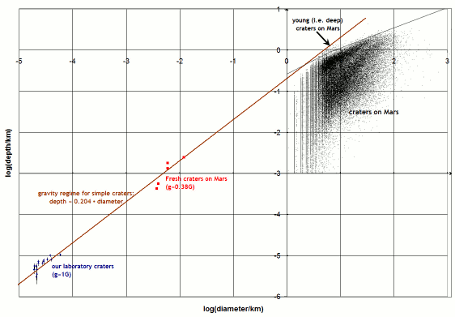|
The main objectives of this work was to develop a simple method for making laboratory craters that could be used as a proxy for real impact craters on Mars. In order to achieve this,
Marin Vojković and Luči Karbonini performed measurements of craters produced in a laboratory and compared the results with measurements for Martian craters provided by Goran Salamunićcar - our collaborator on the project. Laboratory craters were produced in stone powder using silver acetylide as the explosive. Data for Mars are taken from the new GT 115225 catalogue (Salamunićcar G. and Lončarić S. (2010) Trans. Geosci. Remote Sens.). We also included the data on depth and diameter of small fresh Martian craters identified in a recent work on the distribution of mid-latitude ground ice on Mars (Byrne S. et al. (2009) Science, 325, 1674-1676).
The theory of simple impact craters distinguishes between the strength regime and the gravity regime of cratering. The gravity regime is applicable when the soil strength is much smaller then the gravity pressure. The crater properties are then dictated by the impactor's size and velocity and planet surface gravity. This happens for about kilometer-sized impactors, but laboratory experiments showed that craters on soils of negligible strength, such as a dry sand, can extend this regime to much smaller impactor sizes. The simple explosion-induced craters under the gravity regime are geometrically similar under various planetary gravities and explosion energies. This yields a relationship between their depth and diameter:
depth = 0.204 * diameter
We explore if our experimental method produces laboratory craters that fit into this simple depth/diameter description together with the latest data on Mars craters. We show our results together with the Mars craters in the depth-diameter diagram in the figure below. We plotted the analytical prediction from the above equation and find that our data align nicely with the prediction.
We also have a collaboration with Damir Vučina and Igor Pehnec from FESB, Mladen Gomerčić from GOM mbH and Tomislav Hercigonja from Topomatika. They help us with measurments of the crater shape.
The team from FESB performed high-accuracy 3D scans of craters using the device GOM-ATOS-I. The system is based on the principle of stereo- photogrammetry in terms of projecting structured light patterns onto the surface of the object and capturing the image using two cameras. Different line patterns are projected onto the surface in a time sequence to enable simple identification of the spatial positions of measurement points. Based on the stereo scans of the deformed projected lines and using triangulation, the 3D shape of the surface is determined accordingly.
The system employs reference points in order to combine multiple 3D scans into a common graphic object. In particular, 2 CCD cameras with respective resolutions of 1032 x 776 pixels were used with a measurement volume of 250x200mm2.
Salamuniccar, G., Loncaric, S., Vinkovic, D., et al
''Test-field for evaluation of laboratory craters using a Crater Shape-based
interpolation crater detection algorithm and comparison with
Martian and Lunar impact craters''
2012, Planetary and Space Science, 71, 106 (online,
PDF)
G. Salamuniccar, D. Vinkovic, L. Karbonini, M. Vojkovic, S. Loncaric, 41st Annual Lunar and Planetary Science Conference, Houston, USA, 2010, no. 1426. PDF
M. Vojkovic, L. Karbonini, D. Vinkovic, G. Salamuniccar, S. Loncaric, 41st Annual Lunar and Planetary Science Conference, Houston, USA, 2010, no. 1428., PDF

Comparison of our laboratory data and real craters on Mars
|